
Nail psoriasis is a special form of psoriasis in which the nails of the hands and / or feet are affected. Doctors call this type of disease psoriatic onychodystrophy (from Greek.onicos- nail,dis- violation,trophy- Food).
With this article, you will learn about the causes of the development of nail psoriasis, its symptoms, which do not always unequivocally indicate the correct diagnosis, as well as dangerous misconceptions about this form of the disease.
Observation.There are many pictures in the article that can scare an unprepared reader.
Where do nails grow from?
To understand the problem of nail psoriasis, it is important to understand how the so-called nail apparatus works.
The nail has two functions: functional and aesthetic. Firstly, the nail protects the fingertips from damage, increases the precision and sensitivity when working with small objects, can be a weapon of attack or defense and, lastly, with the help of the nails we itch. Second, the aesthetic or cosmetic function of the nails is also important, especially for women.
Nails are formed from the outer layer of the skin - the epidermis. The nail appliance includes:
- nail blade - directly the nail itself,
- matrix - produces the nail plate,
- the nail orifice, or lunula, is the only visible part of the matrix, this is a white moon-shaped area at the base of the nail plate,
- eponychium - a nail roll that protects the matrix from damage,
- nail bed - located under the nail plate and responsible for fixing it to the nail phalanx of the finger,
- hyponychium - the transition zone between the nail bed and the skin of the fingertip.
Causes and mechanism of development of nail psoriasis
In its course - with periodic exacerbations and remissions - psoriasis on the nails resembles a common form of the disease.
Nail psoriasis is believed to develop for the same reasons and in the same pattern as typical psoriatic rashes. Among these reasons, external and internal factors are distinguished.
The main intrinsic factor is the genetic predisposition. External causes are numerous and include, for example, injuries, poor diet, toxics (alcohol and tobacco), infections and certain medications.
The standard mechanism of development of nail psoriasis under the influence of these reasons can be briefly described as follows:
- Provocative factors, such as trauma, activate immune cells.
- The activated immune cells migrate to the area of the nail matrix or nail bed.
- Immune inflammation develops in these areas.
- The division of skin cells is greatly accelerated and its maturation is interrupted.
- There are characteristic symptoms of psoriasis on the nails.
In addition, the cause of nail psoriasis can be considered as a result of the body's inability to adapt to adverse environmental conditions. According to this view, the main cause of psoriasis is an evolutionarily strange habitat.
As a consequence, this evolutionary approach considers an unhealthy diet, lack of sun and drinking water, excess of toxins, lack of normal physical activity, sleep disorders and chronic stress as the direct causes of illness.
Nail psoriasis and psoriatic arthritis are related
The connection between nail damage and psoriatic arthritis has been known for a long time.
Based on observations, the scientists found that psoriatic arthritis is accompanied by nail damage in nine out of ten cases.
But the mechanism of this connection has not been fully studied. However, the authors of several studies, for example, from the Institute of Molecular Medicine in Leeds (United Kingdom), tried to explain this connection beyond the concept of immune inflammation.
For them, the fact is that the finger joint is located next to the nail and is anatomically associated with it.
Therefore, the microtrauma and the Kebner phenomenon that cause primary inflammation of the joints - psoriatic arthritis - also cause secondary pathological changes in the nearest nail.
That is why psoriatic arthritis is so often associated with nail damage.
%20of%20the%20toes.jpg)
Thus, symptoms of nail psoriasis are often indicative of psoriatic arthritis.
Now let's look at the main myths that accompany this disease and how dangerous they are.
Myth 1: Nail psoriasis is rare.
Actually. Apparently, in psoriasis, the nails suffer a lot.
According to various sources, nail psoriasis occurs in the range of 6% to 82% of cases of psoriasis vulgaris. This wide spread in assessing the prevalence of this pathology is explained by problems in its accounting. Medical statistics record visits to doctors first by patients with a common form, and attention is paid to nails second. In scientific research, cases of nail psoriasis are also usually studied only in addition to the main object of interest - psoriasis with skin lesions.
However, several publications say that
up to 80-90% of patients with psoriasis vulgaris reported recurrent nail damage.
And also that nail psoriasis occurs in 90% of patients with psoriatic arthritis and scalp psoriasis.
It should be noted that adults generally suffer from this form of the disease.
According to various sources, in children, nails are affected in about 7 to 37% of cases of psoriasis. Unfortunately, often the manifestations of psoriasis on a child's nails are not given due importance. Parents or doctors believe that it is a variant of the norm or consequence of trauma, or simply do not realize it due to the mild severity of the symptoms.
Myth 2: recognizing nail psoriasis by symptoms is easy
In fact, not always. The fact is that
the nail is able to respond to various diseases with only a limited number of symptoms. Therefore, the manifestations of various nail diseases can look the same.
Obviously, nail psoriasis may be suspected if the patient has severe symptoms of psoriasis vulgaris. However, nail lesions can be minor compared to skin lesions and can be easily ignored by a doctor.
Usually, the more psoriasis on the skin activates, the more severe the damage to the nails.
First, the nails are affected.
And it is also important to know that in 5% of cases, nails may be the only initial manifestation of psoriasis. That is, the classic manifestations of psoriasis on the skin may be completely absent.
The appearance of nail psoriasis depends on the origin of the pathological changes - in the matrix or in the nail bed.
The origin of the symptoms - matrix or bed - is important to consider when choosing a treatment. Therefore, it is necessary to define it correctly.
The symptoms that originate in the nail matrix are:
- thimble symptom,
- white spots and dots (leukonychia),
- red dots in the hole,
- crumbled nails.
Although the cause of these symptoms is at the level of the matrix, as the nail grows, pathological changes appear in the nail plate.
Symptoms, the cause of which is in the nail bed, are:
- detachment of the nail (onycholysis),
- longitudinal bleeding,
- subungual hyperkeratosis,
- symptom of an oil stain.
Next, we'll look at each symptom separately. And let's start with the manifestations that originate in the matrix.
Thimble symptom
The symptom of a thimble appears on the surface of the nail plate with holes or cavities, which look like depressions in a thimble.
These defects occur mainly on the nails, but rarely appear on the feet. As the nail grows, the lumps move from the nail fold to the edge of the nail plate.
The pits in nail psoriasis are usually deep, large and chaotic. They arise due to the detachment of clusters of loose cells from the nail surface, in which division and keratinization are impaired.
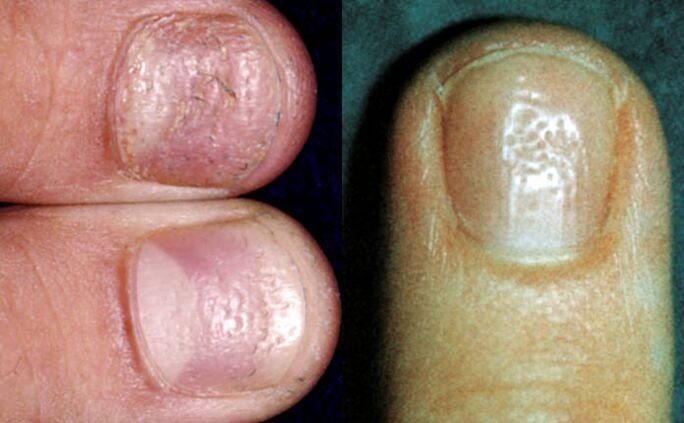
The more severe the psoriasis, the more frequently the thimble symptom occurs.
However, it must be borne in mind that, in addition to psoriasis, the pits in the nails are also characteristic of alopecia areata, eczema, dermatitis and can also occur, for example, with a fungal infection.
Counting the total number of lumps on all nails will help to make the correct diagnosis.
- Less than 20 - not typical for psoriasis,
- from 20 to 60 - psoriasis can be suspected,
- more than 60 - confirm the diagnosis of psoriasis.
White spots (leukonychia)
Leukonychia is a symptom that manifests itself as white spots or spots on the nails.
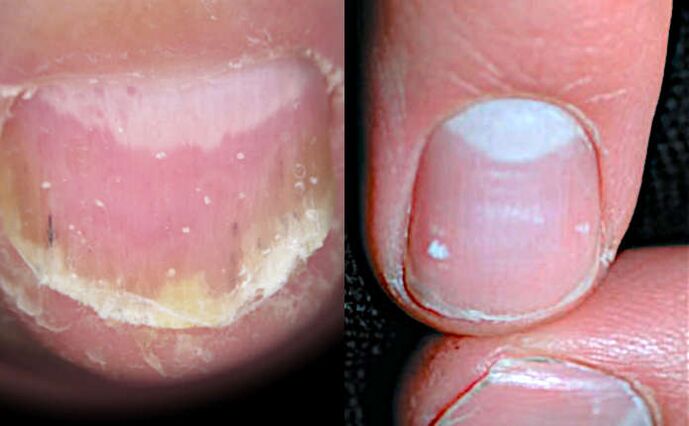
With leukonychia (from Greek.leukós- White andonicos- nail), unlike the superficial pit in the thimble symptom, the cells with impaired division and keratinization are located in the thickness of the nail plate. At the same time, the nail surface remains smooth. And the white color of the spots arises from the reflection of the light from the clusters of vaguely located cells.
However, some studies suggest that leukonychia is so common in healthy people that it is not a characteristic symptom of psoriasis. For example, an injury to the manicure can cause leukonychia.
Crumbled nails
When the superficial pits (thimble symptom) and the deep leukonychia zones (white spots) merge, the nails start to fall apart.

Usually, nail splitting occurs in long-term nail psoriasis.
And the more intense the inflammation of the nail matrix, the more the nail plate is destroyed. In severe cases, the nail may collapse completely and fall.
Red spots in the nail cavity
Apparently, red spots in the orifice area and their general redness occur due to an increase in blood flow to the vessels under the nail.
In addition, red dots in the orifice are formed due to a violation of the structure of the nail plate itself: it becomes more transparent and thinner. And because of this, first, the vessels become more visible and, second, the thin nail plate puts less pressure on the vessels below it, and they are more filled with blood.
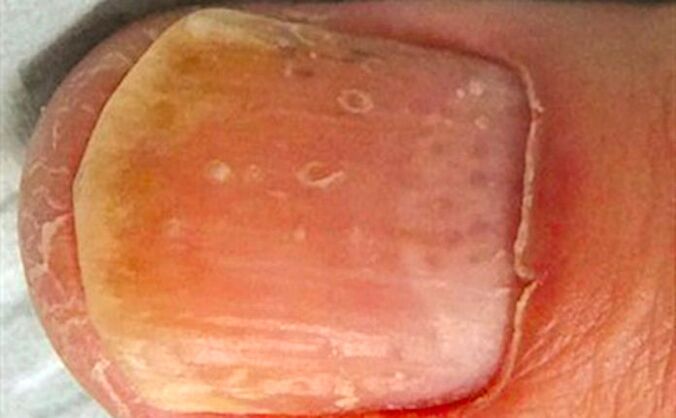
Thinning of the nail plate can also cause redness of the entire nail bed.
Nail detachment (onycholysis)
Now let's consider the symptoms, the origin of which is the nail bed.
Onycholysis is the separation of the nail plate from the bed due to the accumulation of cells under the nail with impaired division and keratinization.

Onycholysis itself (from Greek.onicos- nail andλύσις- separation) is not necessarily a sign of psoriasis and can develop, for example, as a result of nail damage.
Initially, the loss of contact between the nail and the bed occurs in the hyponychia zone - along the outer edge of the nail plate. Then, the onycholysis spreads towards the nail fold in the form of a semicircular line. The exfoliation area turns white due to the accumulation of air under the nail.
A reddish border (scientifically erythema) along the border of onycholysis, which is usually visible on the fingers, is characteristic of psoriasis and helps to make the correct diagnosis.
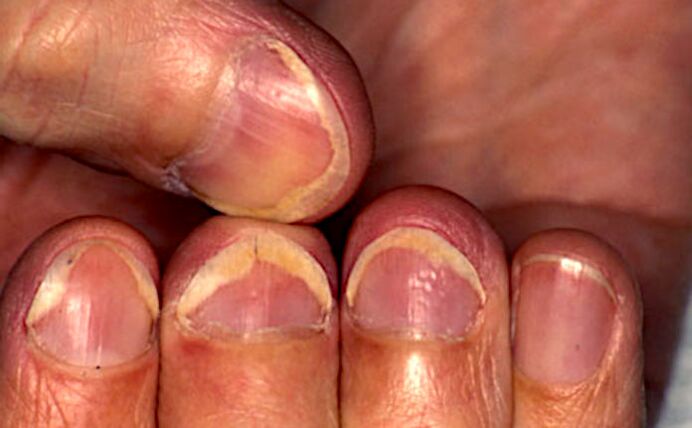
With prolonged onycholysis, the nail bed loses its properties and the new, growing nail will most likely not be able to attach to it normally. Therefore, even with a complete renewal of the nail plate, onycholysis often persists.
Due to the fact that onycholysis facilitates the penetration of bacteria and fungi, the infection can join. This sometimes leads to discoloration of the nail. For example, a greenish color can occur when bacteria settlePseudomonas aeruginosa(Pseudomonas aeruginosa) and others.
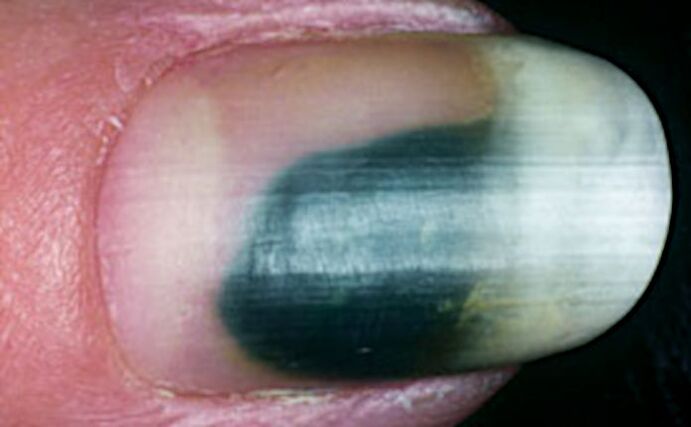
Longitudinal subungual hemorrhage
Longitudinal subungual hemorrhages occur in the nail bed and appear as dark red lines 1-3 mm long.
The increase in blood flow and edema in the area of inflammation of the nail bed lead to the rupture of capillaries, which is manifested in the form of these hemorrhages.
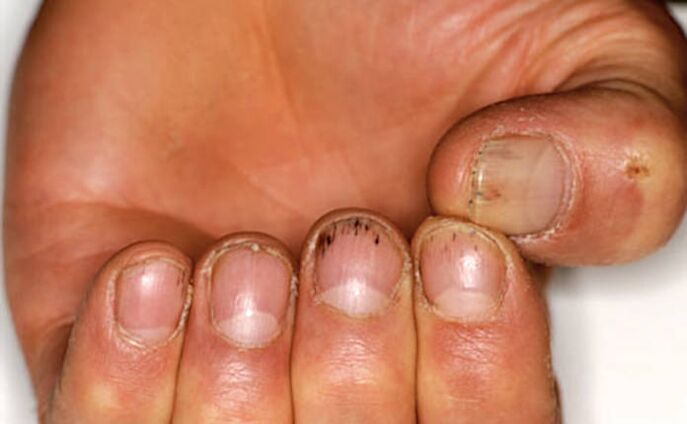
Due to the peculiarities of the blood supply, most hemorrhages occur near the free edge of the nail - in the hyponychia zone.
Subungual hyperkeratosis
Subungual hyperkeratosis is an accumulation of dead cells under the outer part of the nail plate.

With psoriasis, subungual hyperkeratosis (from Greek.hyper- excessively andkeras- horn) is usually silvery white in color, but it can also be yellow. And when the infection joins, it can become, for example, greenish or brown.
The higher the nail rises above the nail bed, the greater the activity of the pathological process.
In the fingers, subungual hyperkeratosis is usually manifested by loose layers under the nail plate. On the legs, these masses are firmly welded with a thick nail.
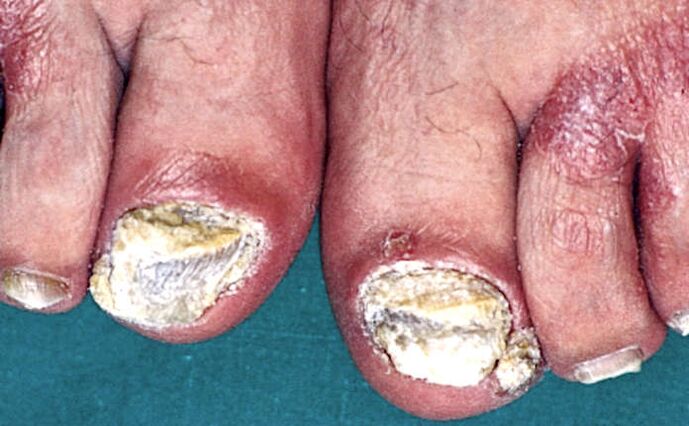
In addition, psoriasis with toenail lesions is characterized by a combination of subungual hyperkeratosis with onycholysis (separation of the nail).
Oil stain symptom
The symptom of an oil stain appears under the nail plate in reddish-yellow stains (salmon).
They arise in the nail bed closest to the nail fold and move towards the edge of the nail as it grows.
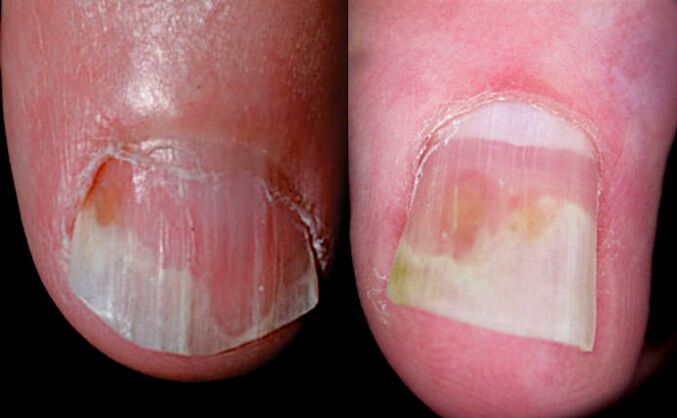
The cause of this symptom is inflammation of the nail bed with expansion of capillaries and accumulation of cells involved in the inflammation, as well as cells with impaired division and keratinization.
Oil stains come in a variety of shapes and sizes. They can be found both in the center of the nail and on the edge, close to the area of onycholysis.
Myth 3: Nail psoriasis is just a cosmetic problem.
In fact, this is not true. Although more than 90% of patients report ugly psoriasis nails, this is not just an aesthetic problem.
According to several studies, nail psoriasis significantly reduces patients' quality of life:
- 52% of patients also complain of pain,
- 59% - for problems in daily activities,
- 56% - for difficulties at home and
- 48% - due to difficulties at work.
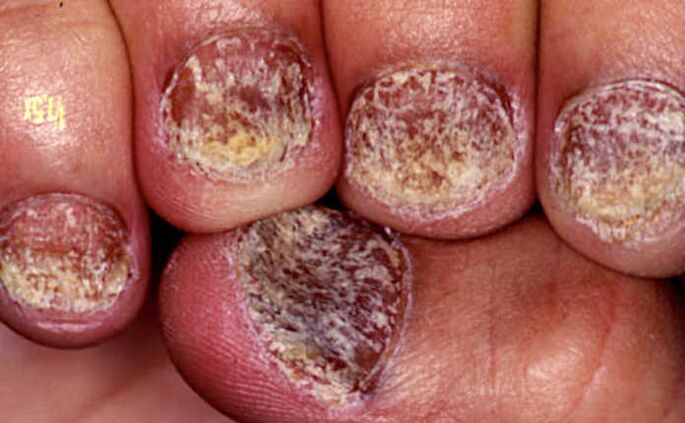
Therefore, it is very important to make the correct diagnosis and start treatment as early as possible, as improving the condition of the nails significantly improves the quality of life of patients with psoriasis.
Myth 4: nail psoriasis is not dangerous
In reality, this is not the case. Speaking above about the causes of this form of the disease, we have already written that
nail psoriasis is an important symptom of psoriatic arthritis.
It is important to keep in mind that the external manifestations of arthritis may be completely absent. In this case, we can talk not only about the fact that the joints of the fingers and toes are affected, but also the joints of the spine and the pelvic bones may be involved.
You can check your joints for arthritis with ultrasound (ultrasound) or magnetic resonance imaging (MRI).
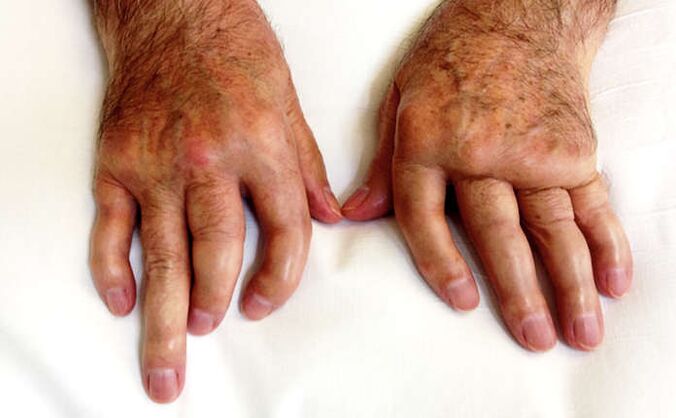
Even if there are no obvious symptoms of arthritis, but there are manifestations of nail psoriasis, it is very important to check that all joints are in order.
And then regularly monitor the condition of the joints. Otherwise, psoriatic arthritis can easily go unnoticed! A late diagnosis will lead to late treatment and, as a result, irreversible joint damage and disability.
Therefore, if the doctor has not ordered an insurance search, citing the absence of visible signs of arthritis, you should contact the clinic and undergo, for example, a remunerated ultrasound examination.
How to diagnose nail psoriasis
It is important to know how to recognize the different symptoms of nail psoriasis, which we have described above, as they help to establish the correct diagnosis. But, as the nail changes characteristic of psoriasis can also occur in other diseases, it can be difficult to make a correct diagnosis immediately.

In this case, the presence of several symptoms at the same time on different nails can aid in the diagnosis.
Important signs of psoriasis on the nails are:
- a symptom of thimble: more than 20 lumps on all fingernails indicate the possibility of psoriasis, and more than 60 lumps confirm the diagnosis of psoriasis,
- detachment of the nail (onycholysis) with a reddish edge around the edge,
- oil stains (salmon) on the nail bed.
Difficulties in diagnosing nail psoriasis for a single symptom
It is especially difficult to diagnose nail psoriasis if it presents with only one symptom.
For example, if you have only onycholysis in your hands or just subungual hyperkeratosis in your arms and / or legs.
The only method for making a reliable diagnosis in isolated onycholysis (detachment of the nail) is probably the study of hyponychia using a special microscope - a dermatoscope.
For this, a high magnification dermatoscope video is used. Note that the portable dermatoscope does not provide the necessary magnification. What is needed is a video dermatoscope with a magnification of at least 40 times. Then, the enlarged capillary loops characteristic of psoriasis become visible.
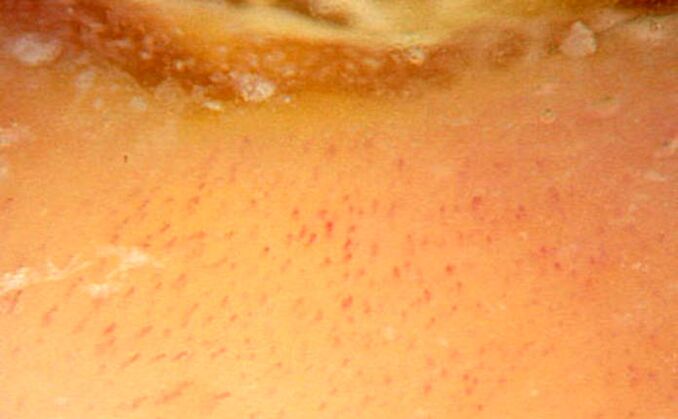
With isolated subungual hyperkeratosis, the likelihood of psoriasis is high if the accumulation of scales under the nail is whitish silver in color, as well as if all fingernails or toenails are affected.
Psoriasis or nail fungus?
Approximately 30% of patients with nail psoriasis also have fungal infection - scientifically onychomycosis.
Externally, hyperkeratosis and onycholysis (separation of the nail) in psoriasis can resemble the manifestations of a fungal infection. Therefore, it can be difficult to make differential diagnoses, that is, to identify the true cause of the changes in the nail plate.
In addition, psoriasis and fungi can affect the same nails at the same time. Most of the time, it occurs in the toes and is mainly a characteristic of elderly patients.
In addition, with a fungal infection, one or both toe nails are often affected. In psoriasis, as a rule, several nails are affected at the same time.
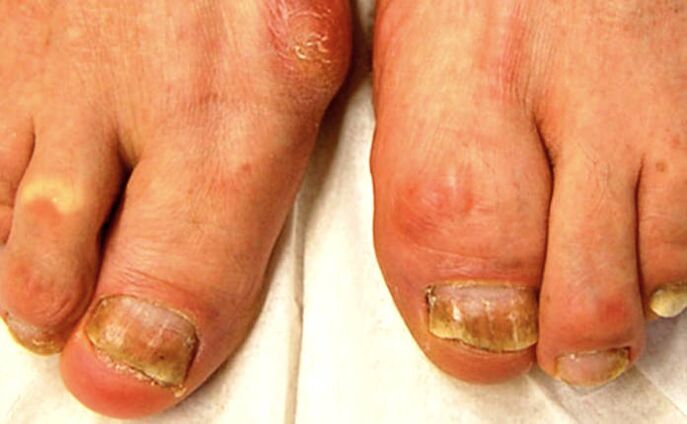
The following symptoms speak in favor of psoriasis:
- oil stains and / or a symptom of thimble on the nails,
- signs of psoriasis on the scalp and / or large folds of the skin,
- periodic remission and exacerbation of nail damage.
In favor of onychomycosis, they say:
- longitudinal stripes on the affected nail,
- detection of fungi during microscopic examination of a scrape treated with potassium hydroxide on an affected nail (KOH test),
- positive culture for fungi.
In general, based on external manifestations alone, it is impossible to completely exclude fungal nail infection in patients with psoriasis.
It should also be remembered that a fungal infection can cause the Kebner phenomenon in the nail and surrounding skin, resulting in symptoms of psoriasis. Anyway
it is useful to go to a mycologist and have a fungi test and, if found, to start antifungal therapy.
Important discoveries and what to do
Let's summarize important information about nail psoriasis and its symptoms.
Diagnostic features:
- Nail psoriasis is very common, but often overlooked.
- Manifestations of nail psoriasis can be minimal, so even experts often do not pay attention to this.
- In 5% of cases, nail damage may be the only symptom of incipient psoriasis.
- The manifestations of different nail diseases can look the same, which further complicates the diagnosis.
The main manifestations of nail psoriasis:
- a symptom of thimble - lumps on the nail,
- white dots,
- ragged nails
- red dots in the hole area,
- detachment of the nail,
- longitudinal subungual hemorrhage,
- subungual hyperkeratosis - loose clumps under the nail,
- symptom of an oil stain.
Psoriasis and fungus:
- Nail psoriasis is often accompanied by a fungal infection.
- To exclude it unequivocally, it is necessary to contact a mycologist and conduct further research.
Nail psoriasis and psoriatic arthritis:
- Nail psoriasis is a common companion to psoriatic arthritis.
- It is important to detect pathological changes in the joints as early as possible to start treatment in time and to avoid irreversible complications and disabilities.
- Even if there are no external symptoms of arthritis, but nail psoriasis is detected, it is necessary to do an examination of the joints using ultrasound or magnetic resonance imaging.























